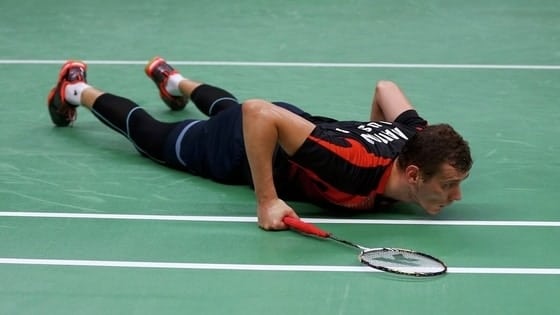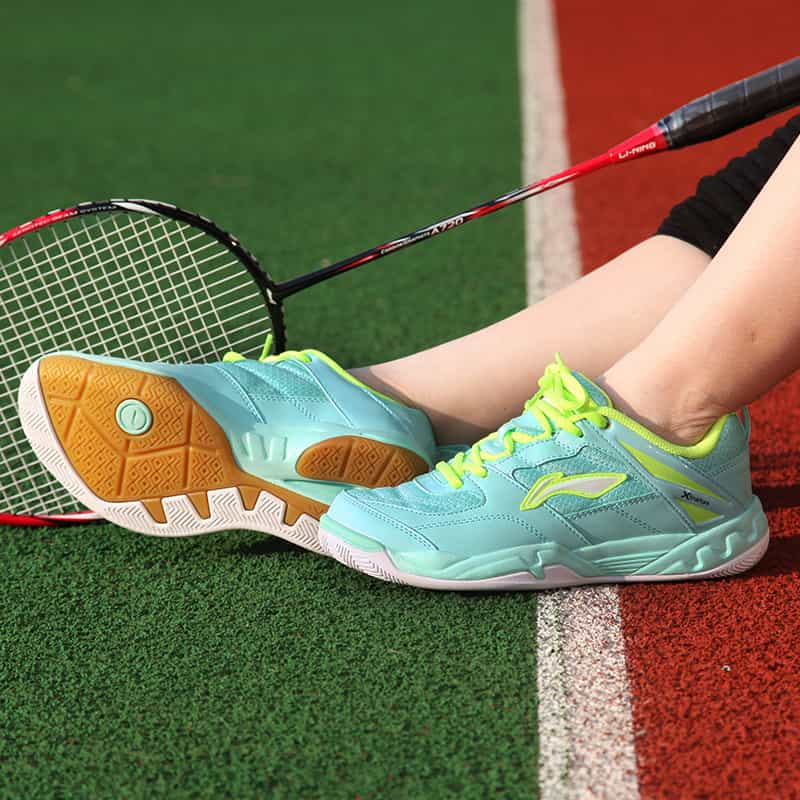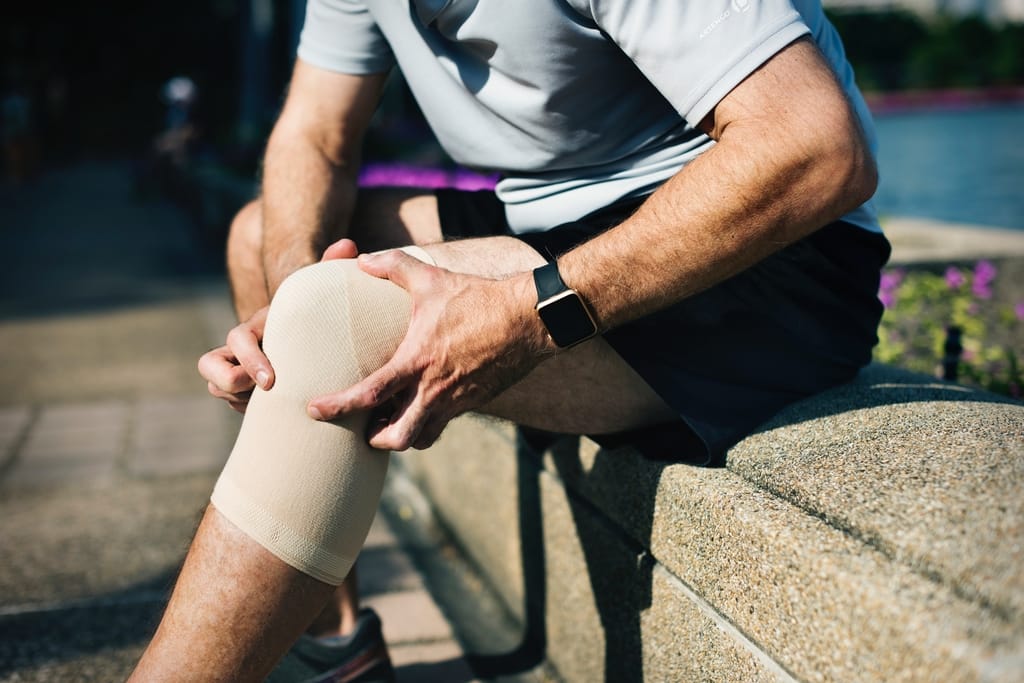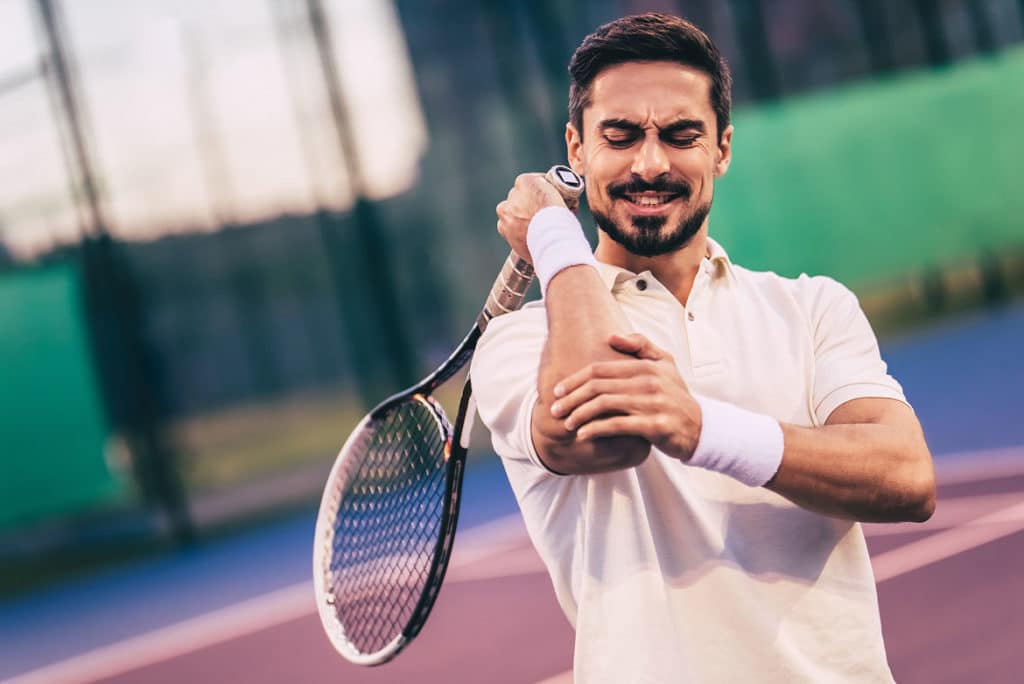Top Badminton injuries | Symptoms-Treatment-prevention
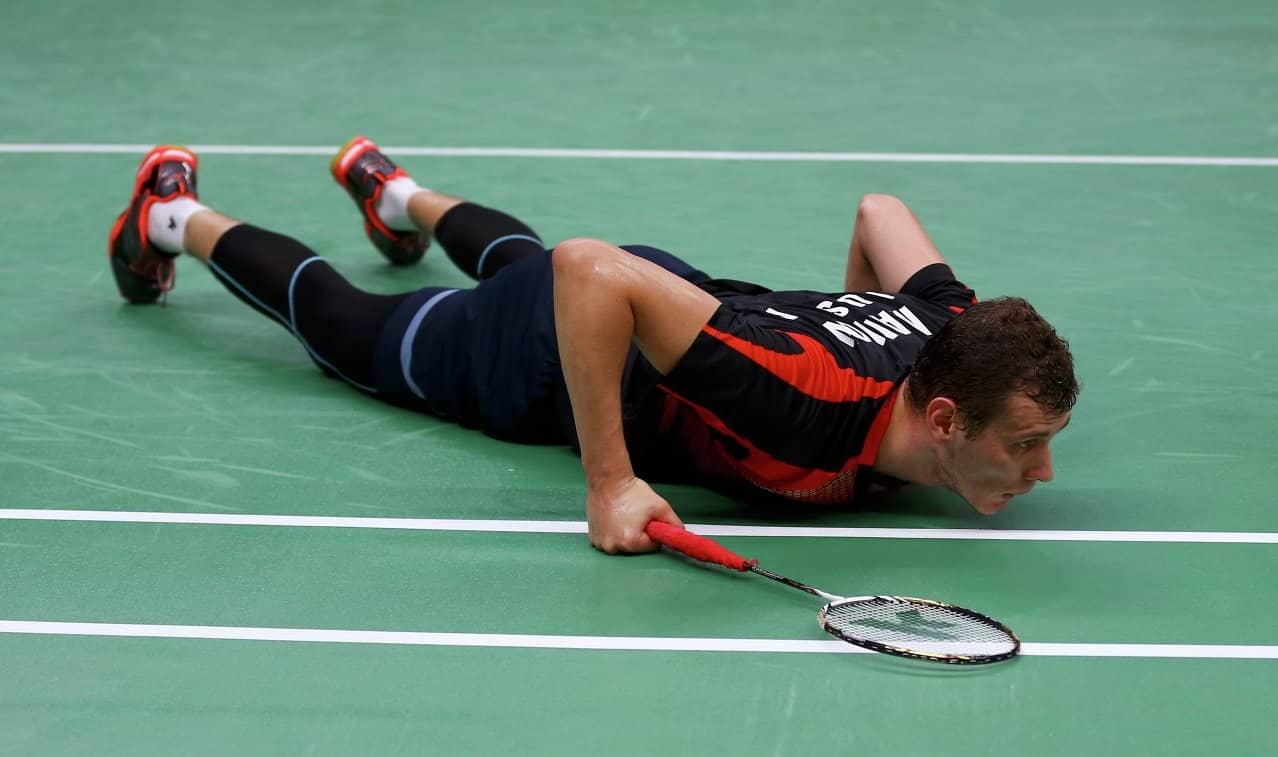
Badminton is a sport with repetitive movements, including powerful contractions of several muscles all over the body.
As a result, some injuries may happen to badminton players while playing as muscle fatigue, pain, inflammation, bruises or even rupture in tendons.
Badminton injuries may occur to any badminton player at any time due to different reasons. Different sites of the body may be affected with different intensities.
In this article, Notbadminton will discuss the different types of badminton injuries, symptoms of each injury, how to prevent and what is the ideal treatment of each type.
Common Cause of badminton injuries
The most common cause of injuries is stretching due to improper footwork (40%) or due to excessive movement (38%). Much less frequently, injuries occurs due to loss of balance (14%) or bruises (8%). Men are injured more often than women.
Common Sites of badminton injuries
The most common type of badminton injuries happens in the lower extremities (58% of all injuries), then the injuries to the upper extremities (31% of all injuries) and back injuries – 11%. The foot and ankle are most often injuries.
Common Types of badminton injuries
Achillodynia is a common trauma, followed by “tennis player’s elbow”, pain in the front of the knee joint, plantar fasciitis and hip muscles.
Lower Limb injuries in badminton (Knee, Ankle & foot)
Badminton high speed, frequent changes in the direction of movement and numerous jumps make high demands on the badminton player’s foot.
As a result, most of injuries in badminton happen on the level of lower limbs.
- Badminton foot injuries and pain
The main problems of the foot in badminton are Achillodynia, ankle sprain, plantar fasciitis, and pain in the heel and sesamoid bone.
1. Achillodynia
Pain in the Achilles tendon and the lubricating tissues surroundings it. Usually develops following overstrain of the tendon after playing for long time.
Symptoms:
Pain, swelling, hotness over the tendon. First, symptoms occur while starting exercise and disappear again once you have warmed up. However, if the condition not treated well, the pain remains for longer times and the swelling no longer goes down.
Treatment:
Initial treatment of achillodynia is always symptomatic treatment:
- Rest and restriction of activity
- Cold fomentation: to relief pain and decrease swelling.
- Hot fomentation: to enhance circulation around the tendon.
- Drugs: anti-inflammatory and painkillers can be taken for one week under supervision of the doctor.
- Insoles: special orthopedic shoe insoles can relieve tension on the Achilles tendon and correct the posture of the body.
- Medical supports: to relieve stress on the Achilles tendon, some special medical supports can be used.
- In some cases, physiotherapy is used, such as deep massage and special eccentric exercises. Exercises to stretch the quadriceps of the thigh and Achilles tendon is highly recommended.
- Some advanced physiotherapy can take place under supervision of doctor as therapeutic ultrasound, acupuncture or electrotherapy.
- If the measures described do not help, surgery may be required.
Recovery and rehabilitation:
After initial improvement, you can gradually begin the rehabilitation process. Doing exercises to stretch the quadriceps of the thigh, strengthen the muscles of the lower limbs in general, and exercises that stimulate proprioception. After 3-4 weeks, badminton players usually start jogging.
Prevention:
Strengthening the muscles of the lower limb through stretching exercises, which will result in achievement of adequate mobility of the ankle joint.
2. Ankle sprain
Injury to the ligaments that surround and connect the bones of the leg to the foot one of the popular injuries in badminton.
It usually happens when your ankle is twisted or turned in a wrong way, which result in overstretch or tear of the ankle ligaments.
Symptoms:
Badminton players who have ankle sprain may suffer from pain, swelling, inability to put weight on the affected ankle, tenderness as well as stiffness.
Treatment:
Conservative treatment is usually enough as rest, use of ice, anti-inflammatory drugs that relieve pressure on the painful area and have a positive effect on the factors that cause injury.
Ankle brace support is recommended to hold the plantar fascia and Achilles tendon in a lengthened position overnight and facilitates stretching.
Prevention:
While playing badminton, you can lower the risk of ankle sprains by:
- Good warming up before exercising
- wearing sturdy, quality footwear
- avoiding high heels
- Wrapping the ankle with ankle tape
3. Plantar fasciitis
Inflammation of a thick band of tissue that runs across the bottom of foot and connects heel bone to toes. It is one of the most common causes of heel pain.
Treatment is the same as ankle sprain. Planter fasciitis stocks is recommended for pain relief.
Read more about Planter fasciitis on Mayo clinic.
- Badminton knee injuries and pain
Patellar tendonitis "Jumper knee"
Patellar tendonitis or jumper knee is a painful condition involving the proximal part of the patellar tendon and the site of its insertion into the distal pole of the patella.
Patellar tendon is the cord-like tissue that connects the patella (knee cap) to the tibia.
It is believed that this injury is a result of repeated micro-fractures and chronic overload on the ligament due to constant jumping, landing, and changing direction, which result in strains, tears, and damage to the patellar tendon.
Symptoms:
- Badminton player suffering from a “jumper knee” experiences sudden pain at the moment of changing the direction of movement over the patellar tendon.
- Knee stiffness, pain particularly while jumping or bending the knee
- Quadriceps muscle pain
Treatment:
For the treatment of mild knee injury:
- Rest
- Modification of activity types, which cause pain by adapting the training regimen to reduce any jumping or completely abandon these types of activity.
- Apply ice on the knee to reduce pain.
- Wearing knee support (called patellar strap or Cho pat strap) to support knee and patella.
- Nonsteroidal anti-inflammatory drugs to reduce pain.
- Massage therapy.
- An important element of treatment is a rehabilitation program of eccentric power exercises.
If pain still persist for long time or severe damage to the tendon is present, surgery may be done after investigations as x-ray or MRI.
Recovery and rehabilitation:
Recovery from jumper’s knee injury ranges from few weeks in mild cases to several months in severe injuries. A rehabilitation program should be done after surgery for several months and involves strengthening exercises and massage.
Prevention:
The most effective factor in preventing knee pain while playing badminton, particularly patellar tendonitis, is stretching. A good warm-up regimen to stretch the quadriceps, hamstring, and calf muscles can help in prevention jumper’s knee.
It’s preferred to stretch after exercising, too.
Medical supports for Badminton injuries
Abco Tech Patella Knee Strap for Knee Pain Relief
Cho-Pat Dual Action Knee Strap
superfeet full length insoles for Planter fasciitis
PowerLix Ankle Brace Compression Support Sleeve
Upper Limb injuries in badminton (Shoulder & elbow)
As all racket sports, hand has a great role in badminton to hit the shuttle in different directions.
Some injuries are common in badminton on the level of the upper limb as tennis elbow, shoulder pain and rotator cuff injury.
- Badminton elbow injuries and pain
Lateral epicondylitis (Tennis Elbow)
A condition characterized by pain around the outside of the elbow in the area of the onset of the extensor muscles of the forearm on the lateral epicondyle of the humerus (the arm bone).
It occurs as a result of prolonged excessive loads on the muscles and tendons of the forearm near the elbow joint that cause numerous micro-breaks and inflammation near the bony lump (the lateral epicondyle).
According to patient.info, about 1 to 3 people in 100 have tennis elbow. It mainly affects people between the ages of 40 and 50.
Women and men are affected equally. Despite being called tennis elbow, racquet sports are only thought to be the cause in about 5 in 100 cases.
Symptoms:
- Pain on the outer side of the elbow
- Stiffness on extending the forearm
- This pain increases while lifting heavy things, bending or twisting the forearm
- Pain also increases while gripping the badminton racket
Sometimes pain occurs during passive maximum flexion of the carpal joint with the elbow joint straightened. Often there is limited flexion of the carpal joint on the injured side.
It is very important to accurately diagnose, since there may be other causes of pain in this area.
Treatment:
NHS.UK website mentioned that treatment should begin with an accurate analysis of the mechanism of damage in order to get a good result in short time:
- Conservative treatment: ice, rest, stretching exercises, deep massage, anti-inflammatory nonsteroidal drugs, transcutaneous nerve stimulation.
- A power exercise program is applied, which includes extending, flexing and rotating the carpal joint after controlling pain sensations.
- It is often advisable to use a locking device such as a Elbow brace, strapping, support bandage or splint
- Cortisone injections may be prescribed in certain cases.
- Shockwave therapy and PRP injections.
- Surgery may be needed as the last choice in cases with severe and persistent pain.
Prevention:
The rotators of the forearm, as well as the muscles of the shoulder and upper arm play a great role in badminton;
Therefore, exercises for developing strength and flexibility play an important role in preventing this damage.
- Badminton shoulder injuries and pain
Rotator cuff injury
The rotator cuff is a group of muscles and tendons that surround the shoulder joint, keeping the head of your upper arm bone firmly within the shallow socket of the shoulder. Source: Mayo clinic
Symptoms:
The main symptom is pain in the front of the shoulder joint. Pain may be felt in the affected weak or overloaded muscles. Sometimes there is some instability of the shoulder joint.
Pain increases with moving the arm above the head and to the back as in combing.
Treatment:
- As most of badminton injuries, conservative treatment is enough in most cases.
- Shoulder support with shoulder brace may be useful to decrease pain.
- Your doctor might recommend steroid injection and physiotherapy, especially if the pain is interfering with daily activities or lasting for long time.
- Surgery may be done in severe cases.
Prevention:
Strengthening exercises and shoulder stretches every day can help in prevention of future injury.
It is very important to strengthen the front muscles of the chest, shoulder, arm as well as the muscles in the back of the shoulder and around the shoulder girdle to keep the balance in all shoulder muscles.
Medical supports for Badminton injuries
Simien Tennis Elbow Brace – Compression Pad
Nordic Elbow Sleeves Support & Compression
Shoulder Brace Support for Torn Rotator Cuff
Medi Achimed Knit Ankle Support for badminton
Back injuries
Back pain
The game of badminton requires a very stable body as the basis for the movements of all four limbs. The abdominal muscles and back muscles must be in very good condition.
Often the cause of pain in the back area of badminton players is due to fatigue in iliopsoas muscle.
When this muscle is overloaded, it contracts and leads to increase in lumbar lordosis, which increases the load on the lower back.
The stiffness of this muscle can be identified using the Thomas test.
Treatment:
The treatment program should include rest and exercises for stretching and repetition of exercises with a little effort in one direction.
Painkillers and anti-inflammatory medications may be used. You can wear Back support brace for sometime to decrease pain.
Prevention:
Stretching exercises and strength exercises for the muscles of the back and abdomen (flexors, extensors, oblique muscles).
Tips to prevent badminton injuries
- 1. Changing the design of shoes: increasing the heel, increasing the damping qualities and stiffness.
- 2. Adaptation of friction between the shoes and the playing surface.
- 3. Specific workouts, including exercises to stretch and strengthen the quadriceps muscles of the thigh, as well as the muscles involved in the rotation of the shoulder(cuff rotator muscles), elbow and wrist joints.
- 4. Mandatory general warm-up for all muscle groups and a special warm-up, as well as a relaxation after a workout.
Duration of injury treatment
The average duration of injury treatment in badminton is quite high (48 days). However, the number of missed working days due to injury is low (2-4 days). This reflects a high percentage of fatigue damage in this sport.
Despite the previous injuries, badminton is still a sport with a low risk of injury, as it is a non-contact sport.
The number of injuries in badminton is lower than in other sports and most of these injuries in badminton are fatigue injuries and resolves within days.
For these reasons, badminton is a suitable sport for kids.

